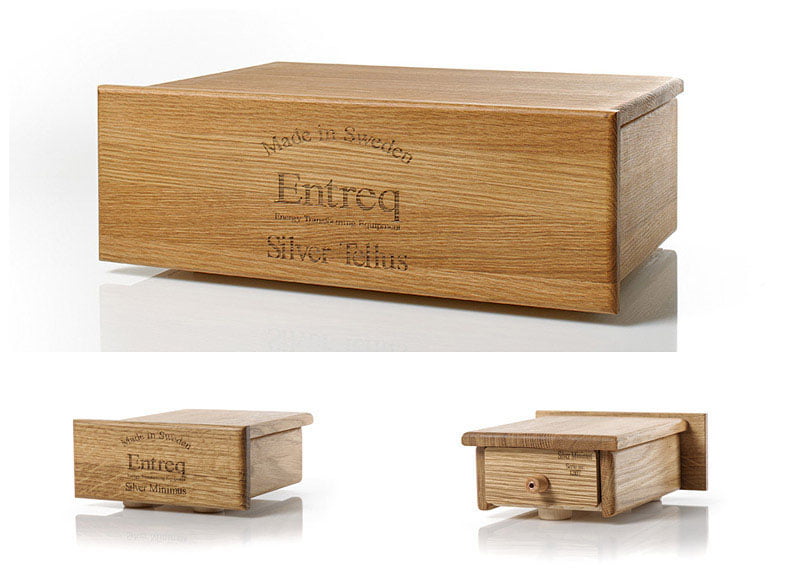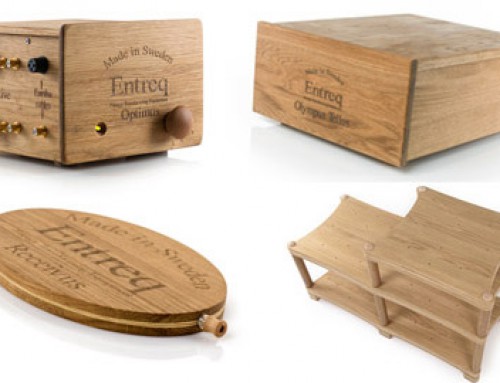Any discussion of the Entreq range has to start with their grounding products, not just because its fundamental to their whole approach but also because nearly all their other products like signal interconnects and mains cables, can themselves be grounded to further upgrade their performance.
Passive grounding of audio equipment might be a completely new concept to you or you may have recently seen a few other companies offering products which offer something similar. Whichever camp you fall in, rest assured that Entreq have been doing this for about 15 years and simply hooking a single ground cable onto any piece of your equipment is a most irrefutable and startling AB demo, not least because it takes just seconds to perform but also requires no electric current.
In short, most people just can’t understand why a cuddly little wooden box with some metal parts and some minerals in it can do so much. Well the theory in very simplistic form is that Entreq believe that a clean and effective ground point is one of the most important factors in ensuring the best possible sonic results from any hifi system. Their years of research has shown that drawing away unwanted noise, capacitor discharge, field effects, stray magnetic currents and creating a stable ground plane free from fluctuations is far more important that one would ever imagine. The beauty of this technology though is just how neat and simple it is. Draining away these contaminents is quick and simple, very easy to demo and completely independent of mains or electric power. The price of admission also begins at a fairly modest £250 for a single grounding box and copper cable.

Let’s begin by introducing the range of grounding boxes on offer. These boxes are beautifully made and are unexpectedly heavy with a lovely robust feel to them. I personally love their overall persona. The packaging is first rate and they even have a very pleasing rustic smell to them too. Like all Entreq items, the earthy ‘look and feel’ kind of foreshadows the sort of sound you are going to get too.
At lotus I will be primarly focusing on the Silver Minimus (£400) and Silver Tellus (£1550). The Silver Tellus will be the model of choice for most premium and high end systems. It has four dedicated ground outlets and can handle up to eight devices so for the most part will serve all your grounding needs. The mineral mix inside the box is an upgraded composition with 30% more silver than the original Tellus. The Silver Minimus has this same enhanced mineral mix and therefore grounding power but just one single outlet. This unit is relatively inexpensive at £400 and is a great solution for people wishing to dip their toe in or who feel they only wish to ground one or two devices in their system. It is also very useful if you have power amps for example, situated some way away from the main system.

In the picture above you can see the unboxing of the Silver Tellus. This is almost as wide and deep as a standard sized piece of equipment. The box is beautifully made, very tasteful and surprisingly weighty, about the same as a regular power amp.
The other grounding boxes on offer are the Tellus at £750 with standard mineral mix. This is a 3 outlet box for use with up to 6 devices so plenty of functionality to ground a whole system. There is also the little Minmus for just £200, similar to the Silver Minimus but again, with the standard mineral composition. I have to say, this is a very compelling price especially for budget and entry level systems where maximising performance of what already exists is paramount. Add a copper cable and for a total spend of £250 there really aren’t any other ways i can think of to significantly improve a whole system for such little outlay.

I’ll get onto the actual sound and what these grounding boxes do in a minute but lets just talk a little about how you wire everything up. To connect your equipment to the grounding boxes you can use spare RCA inputs or outputs, spare XLR inputs or outputs (male or female) or chassis screws and ground screws. To this effect, there are “Ertha” cables termintated at one end in RCA, XLR and Spade. The final and fourth type of cable to mention goes to a 3.5mm mini headphone jack and these are used specifically for grounding other Entreq cables. The Entreq range of interconnects, mains cables and speaker cables can themselves be grounded and have a small female 3.5 socket coming off them so this is where you would use an “Ertha” 3.5.
Down below you can see various grounding cables, an RCA on the top right, a 3.5 bottom right.

You may have guessed that each of these cables also come in various materials or grades which sit in a price scale. The types we will be focusing on at LOTUS are the Copper, Silver and Apollo. These seem to typify the range and offer the sweet spot solutions. The thing with grounding cables though is the most expensive is not necessarily the most favourable. I have found in my trials that its best to experiment and the type of cable that suits you best will depend on the piece of equipment that you are groudning, your overall system and listening preferences.
A word on the grounding wire construction. They are extremely light and flexible and route around your kit with considerable ease. The wooden connectors are great to touch, solid and well made. The connections and heatshrink areas are very secure and generally I find the Ertha cables easy on the eye and they blend into your living space in a tasteful, unostentatious manner.

Up above we have an Ertha Apollo RCA. The Apollo is not quite top of the range but as high as most people will want to go.

Here you can see the Silver Minimus plugged into a Vitus Integrated amp using an Ertha Silver XLR (male).

Look from the rear the Ertha cable simply pops into a spare XLR input, either channel … it doesn’t matter.

On the back of the Silver Tellus I have all 4 outlets connected although its only half maxed as each will support up to 2 wires.

Ertha Apollo RCA into a spare digital input of the Vitus DAC. Challenger USB cable (more on that later) which is also grounded back to the Silver Tellus (see the double 3.5m jack connection).

So how does it all sound and what exactly do these strange wooden boxes do ? Well let’s start by telling you what the Entreq sound isn’t. This company is not about pyrotechnics. It won’t try and make the sound more exciting or more forward in certain frequencies. The music doesn’t sound faster or any sharper and it certainly doesn’t sound etched or analytical. No, Entreq is about low noise, naturalness, stability, musical flow and the tune and coherency of the music.
The effect of just one cable on one piece of equipment (dac, preamp, phono, power amp or otherwise) is immediate and obvious. You will notice a large reduction in noise particularly in the high frequencies. This can at first manifest itself in the sense that the sound has become a little darker but you realise that actually a lot of poorly articulated high frequency information has now been better organised and just generally cleaned up and the backgrounds are much blacker. Secondly and possibly the most striking thing is the whole soundfield has a stability and poise that was not there before. Sounds and instruments/performers are firmly locked in place and piano notes that were formerly smeared across the x axis in both speakers are now emanating correctly from a single point in space. The entire track has a locked-in solidity that appears divorced from the speakers; the character of the system is notably assured and measured whereas in its previous incarnation, the same tracks seemed chaotic and messy. The final change to mention is general timing and coherency. Like Rick Schultz’s cables, the Tellus does something to the leading edge of notes. They don’t sound any sharper or faster but you are aware that they are cleaner and less cluttered and I think mainly because of this, the rhythmical flow, the musical phrasing and patterns become more meaningful, intelligible and easier to follow. In short, timing takes a very worthwhile leap.
As a footnote it’s also worth pointing out that all of these changes do not alter the fundamental flavour of your setup. As one forum user correctly pointed out, if you like what your system does already then you’re in for a special treat.
After the first 10 minutes or so I found that these improvements from the Tellus box continued increasing in magnitude for the next half an hour or so. A day or so later there was even more improvement too and it was at this point that I felt that the microdetail and texture of instruments had gotten better as well. After a few days more i then did the most startling test and that was to pull the grounding wire off and instantly the system went back to how it was and by comparison sounded bright, harsh, chaotic and ossilating raggedly in space. I won’t spent too much time on my further experiments but suffice to say that the more boxes you ground, the effects appear cumulative and you get more improvements across the board. Along with the mains cables I basically took a system that was merely ‘good’ to something truly special and delicious to savour. In fact for days afterwards I found myself really surprised at some of the components I was using; I thought I knew them well but it was really amazing to get this whole new performance level out of them. Entreq teaches us in no uncertain terms that we should extract the best from our boxes before we move onto changing boxes again. In most instances there is so much more to come from our systems as we know them.









CONNECT WITH US